Anthropology: Worldview and Religion Analysis of Virgin and Marx
VerifiedAdded on 2023/01/18
|8
|2092
|36
Essay
AI Summary
This essay delves into the intersection of worldview and religion, examining the Virgin of Guadalupe as a powerful symbol within Mexican and Mexican-American Catholic communities. It explores the historical and cultural significance of the Virgin, analyzing her representation of faith, identity, and social justice. Additionally, the essay evaluates Karl Marx's perspective on religion, discussing his views on its role in society, its function as a form of social control, and its relationship to economic and political structures. The analysis includes examples to support Marx's arguments, contrasting his views with other interpretations of religion's impact on social change and individual consciousness. The essay highlights the diverse roles of religion in both maintaining and challenging social orders.
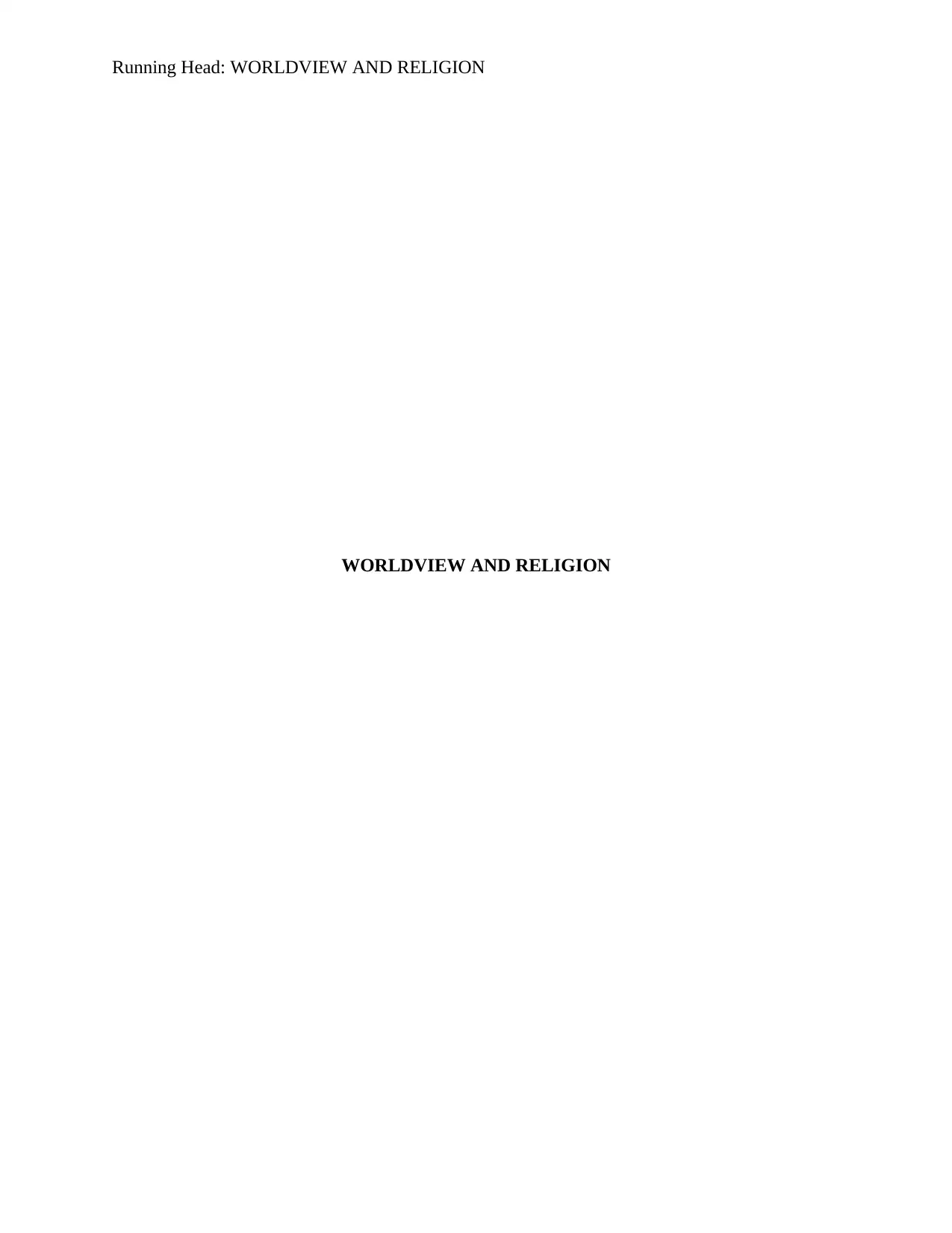
Running Head: WORLDVIEW AND RELIGION
WORLDVIEW AND RELIGION
WORLDVIEW AND RELIGION
Paraphrase This Document
Need a fresh take? Get an instant paraphrase of this document with our AI Paraphraser
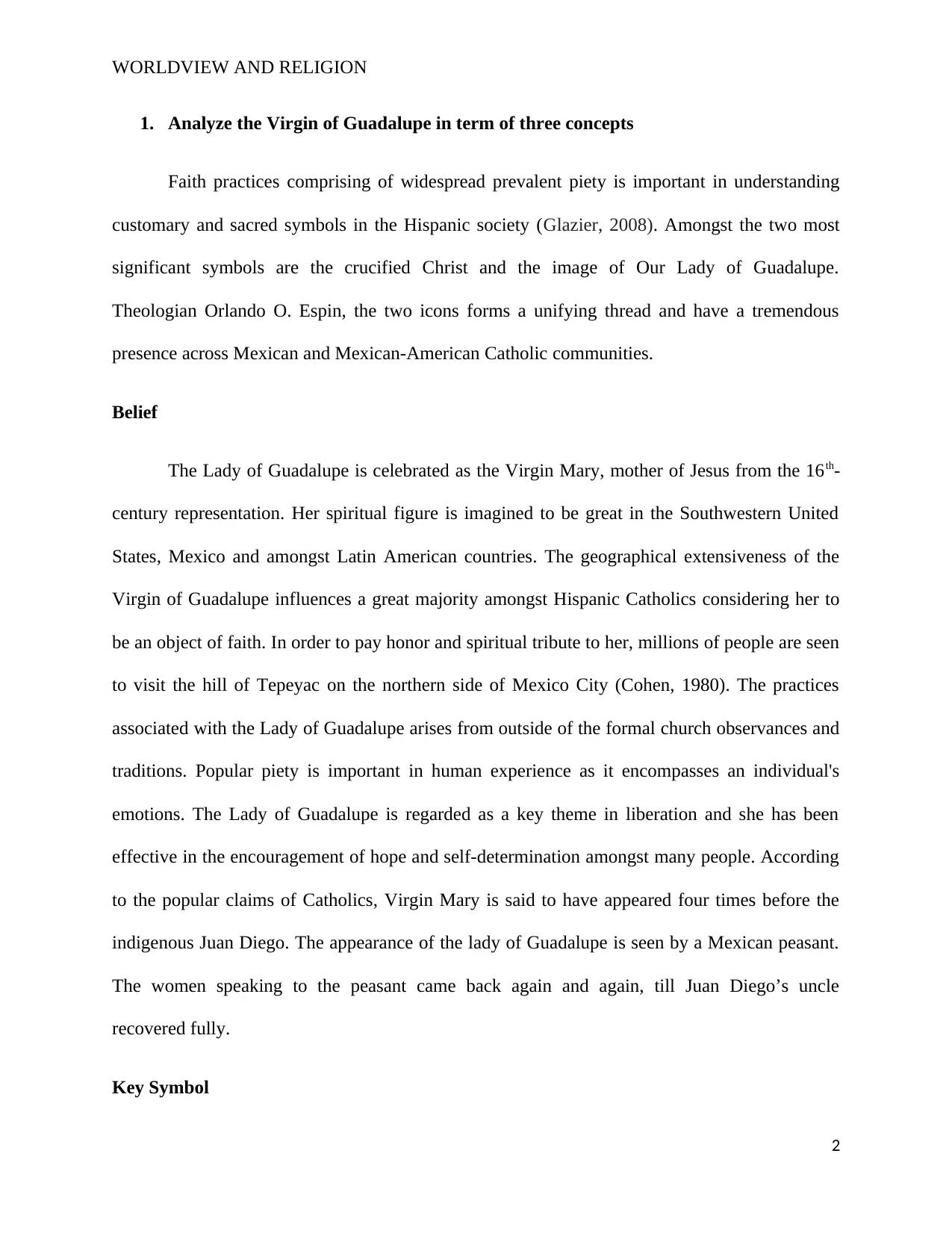
WORLDVIEW AND RELIGION
1. Analyze the Virgin of Guadalupe in term of three concepts
Faith practices comprising of widespread prevalent piety is important in understanding
customary and sacred symbols in the Hispanic society (Glazier, 2008). Amongst the two most
significant symbols are the crucified Christ and the image of Our Lady of Guadalupe.
Theologian Orlando O. Espin, the two icons forms a unifying thread and have a tremendous
presence across Mexican and Mexican-American Catholic communities.
Belief
The Lady of Guadalupe is celebrated as the Virgin Mary, mother of Jesus from the 16th-
century representation. Her spiritual figure is imagined to be great in the Southwestern United
States, Mexico and amongst Latin American countries. The geographical extensiveness of the
Virgin of Guadalupe influences a great majority amongst Hispanic Catholics considering her to
be an object of faith. In order to pay honor and spiritual tribute to her, millions of people are seen
to visit the hill of Tepeyac on the northern side of Mexico City (Cohen, 1980). The practices
associated with the Lady of Guadalupe arises from outside of the formal church observances and
traditions. Popular piety is important in human experience as it encompasses an individual's
emotions. The Lady of Guadalupe is regarded as a key theme in liberation and she has been
effective in the encouragement of hope and self-determination amongst many people. According
to the popular claims of Catholics, Virgin Mary is said to have appeared four times before the
indigenous Juan Diego. The appearance of the lady of Guadalupe is seen by a Mexican peasant.
The women speaking to the peasant came back again and again, till Juan Diego’s uncle
recovered fully.
Key Symbol
2
1. Analyze the Virgin of Guadalupe in term of three concepts
Faith practices comprising of widespread prevalent piety is important in understanding
customary and sacred symbols in the Hispanic society (Glazier, 2008). Amongst the two most
significant symbols are the crucified Christ and the image of Our Lady of Guadalupe.
Theologian Orlando O. Espin, the two icons forms a unifying thread and have a tremendous
presence across Mexican and Mexican-American Catholic communities.
Belief
The Lady of Guadalupe is celebrated as the Virgin Mary, mother of Jesus from the 16th-
century representation. Her spiritual figure is imagined to be great in the Southwestern United
States, Mexico and amongst Latin American countries. The geographical extensiveness of the
Virgin of Guadalupe influences a great majority amongst Hispanic Catholics considering her to
be an object of faith. In order to pay honor and spiritual tribute to her, millions of people are seen
to visit the hill of Tepeyac on the northern side of Mexico City (Cohen, 1980). The practices
associated with the Lady of Guadalupe arises from outside of the formal church observances and
traditions. Popular piety is important in human experience as it encompasses an individual's
emotions. The Lady of Guadalupe is regarded as a key theme in liberation and she has been
effective in the encouragement of hope and self-determination amongst many people. According
to the popular claims of Catholics, Virgin Mary is said to have appeared four times before the
indigenous Juan Diego. The appearance of the lady of Guadalupe is seen by a Mexican peasant.
The women speaking to the peasant came back again and again, till Juan Diego’s uncle
recovered fully.
Key Symbol
2
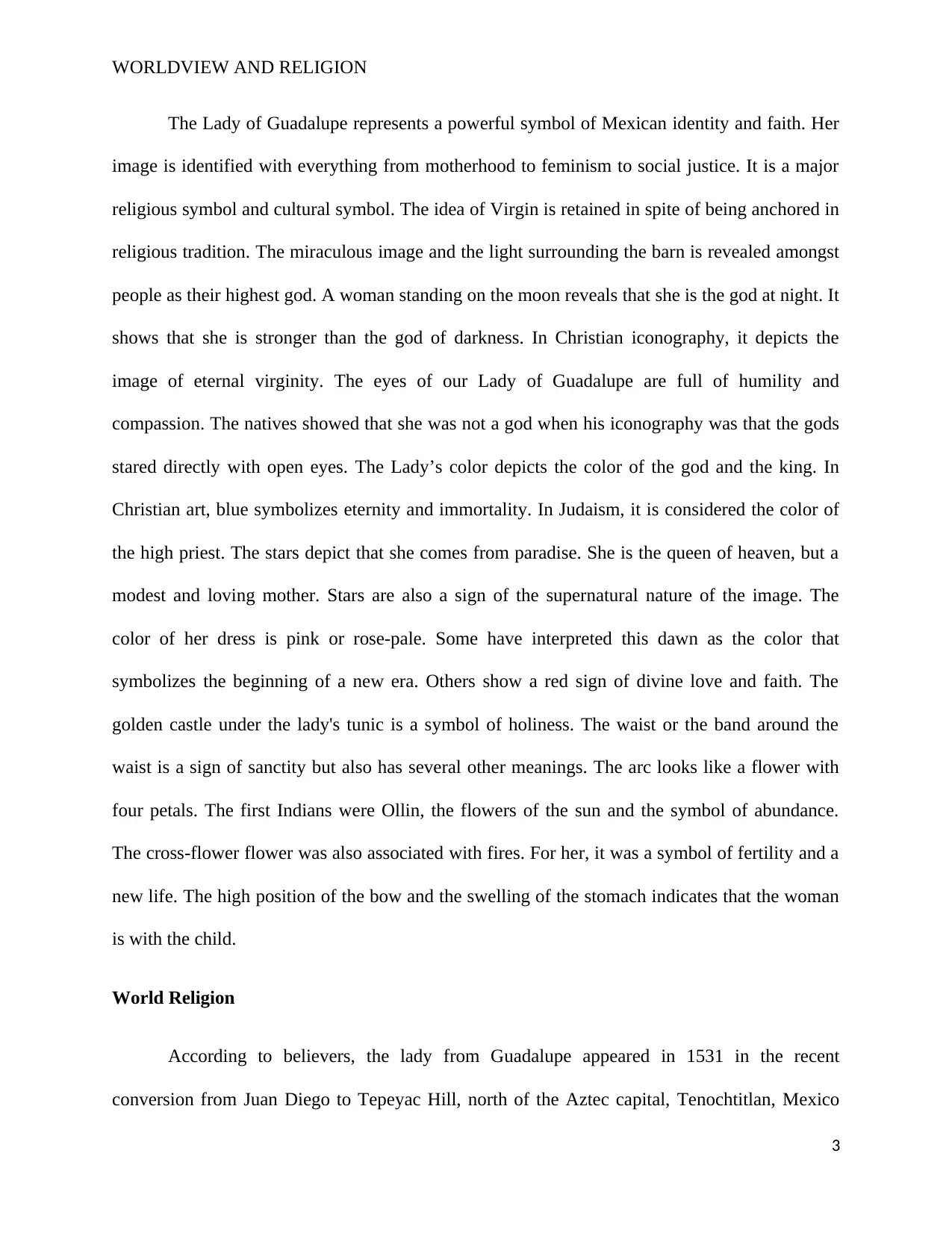
WORLDVIEW AND RELIGION
The Lady of Guadalupe represents a powerful symbol of Mexican identity and faith. Her
image is identified with everything from motherhood to feminism to social justice. It is a major
religious symbol and cultural symbol. The idea of Virgin is retained in spite of being anchored in
religious tradition. The miraculous image and the light surrounding the barn is revealed amongst
people as their highest god. A woman standing on the moon reveals that she is the god at night. It
shows that she is stronger than the god of darkness. In Christian iconography, it depicts the
image of eternal virginity. The eyes of our Lady of Guadalupe are full of humility and
compassion. The natives showed that she was not a god when his iconography was that the gods
stared directly with open eyes. The Lady’s color depicts the color of the god and the king. In
Christian art, blue symbolizes eternity and immortality. In Judaism, it is considered the color of
the high priest. The stars depict that she comes from paradise. She is the queen of heaven, but a
modest and loving mother. Stars are also a sign of the supernatural nature of the image. The
color of her dress is pink or rose-pale. Some have interpreted this dawn as the color that
symbolizes the beginning of a new era. Others show a red sign of divine love and faith. The
golden castle under the lady's tunic is a symbol of holiness. The waist or the band around the
waist is a sign of sanctity but also has several other meanings. The arc looks like a flower with
four petals. The first Indians were Ollin, the flowers of the sun and the symbol of abundance.
The cross-flower flower was also associated with fires. For her, it was a symbol of fertility and a
new life. The high position of the bow and the swelling of the stomach indicates that the woman
is with the child.
World Religion
According to believers, the lady from Guadalupe appeared in 1531 in the recent
conversion from Juan Diego to Tepeyac Hill, north of the Aztec capital, Tenochtitlan, Mexico
3
The Lady of Guadalupe represents a powerful symbol of Mexican identity and faith. Her
image is identified with everything from motherhood to feminism to social justice. It is a major
religious symbol and cultural symbol. The idea of Virgin is retained in spite of being anchored in
religious tradition. The miraculous image and the light surrounding the barn is revealed amongst
people as their highest god. A woman standing on the moon reveals that she is the god at night. It
shows that she is stronger than the god of darkness. In Christian iconography, it depicts the
image of eternal virginity. The eyes of our Lady of Guadalupe are full of humility and
compassion. The natives showed that she was not a god when his iconography was that the gods
stared directly with open eyes. The Lady’s color depicts the color of the god and the king. In
Christian art, blue symbolizes eternity and immortality. In Judaism, it is considered the color of
the high priest. The stars depict that she comes from paradise. She is the queen of heaven, but a
modest and loving mother. Stars are also a sign of the supernatural nature of the image. The
color of her dress is pink or rose-pale. Some have interpreted this dawn as the color that
symbolizes the beginning of a new era. Others show a red sign of divine love and faith. The
golden castle under the lady's tunic is a symbol of holiness. The waist or the band around the
waist is a sign of sanctity but also has several other meanings. The arc looks like a flower with
four petals. The first Indians were Ollin, the flowers of the sun and the symbol of abundance.
The cross-flower flower was also associated with fires. For her, it was a symbol of fertility and a
new life. The high position of the bow and the swelling of the stomach indicates that the woman
is with the child.
World Religion
According to believers, the lady from Guadalupe appeared in 1531 in the recent
conversion from Juan Diego to Tepeyac Hill, north of the Aztec capital, Tenochtitlan, Mexico
3
⊘ This is a preview!⊘
Do you want full access?
Subscribe today to unlock all pages.

Trusted by 1+ million students worldwide
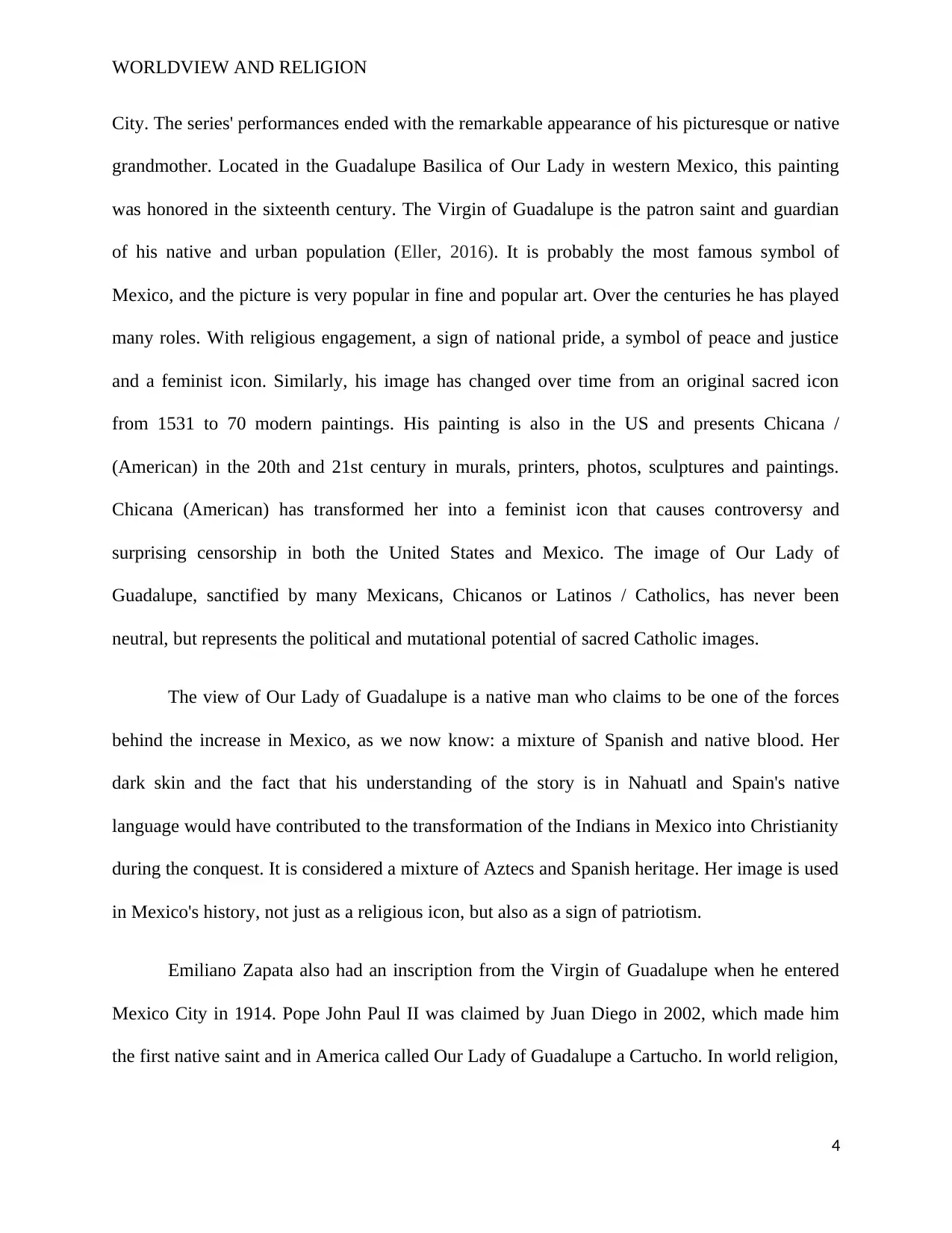
WORLDVIEW AND RELIGION
City. The series' performances ended with the remarkable appearance of his picturesque or native
grandmother. Located in the Guadalupe Basilica of Our Lady in western Mexico, this painting
was honored in the sixteenth century. The Virgin of Guadalupe is the patron saint and guardian
of his native and urban population (Eller, 2016). It is probably the most famous symbol of
Mexico, and the picture is very popular in fine and popular art. Over the centuries he has played
many roles. With religious engagement, a sign of national pride, a symbol of peace and justice
and a feminist icon. Similarly, his image has changed over time from an original sacred icon
from 1531 to 70 modern paintings. His painting is also in the US and presents Chicana /
(American) in the 20th and 21st century in murals, printers, photos, sculptures and paintings.
Chicana (American) has transformed her into a feminist icon that causes controversy and
surprising censorship in both the United States and Mexico. The image of Our Lady of
Guadalupe, sanctified by many Mexicans, Chicanos or Latinos / Catholics, has never been
neutral, but represents the political and mutational potential of sacred Catholic images.
The view of Our Lady of Guadalupe is a native man who claims to be one of the forces
behind the increase in Mexico, as we now know: a mixture of Spanish and native blood. Her
dark skin and the fact that his understanding of the story is in Nahuatl and Spain's native
language would have contributed to the transformation of the Indians in Mexico into Christianity
during the conquest. It is considered a mixture of Aztecs and Spanish heritage. Her image is used
in Mexico's history, not just as a religious icon, but also as a sign of patriotism.
Emiliano Zapata also had an inscription from the Virgin of Guadalupe when he entered
Mexico City in 1914. Pope John Paul II was claimed by Juan Diego in 2002, which made him
the first native saint and in America called Our Lady of Guadalupe a Cartucho. In world religion,
4
City. The series' performances ended with the remarkable appearance of his picturesque or native
grandmother. Located in the Guadalupe Basilica of Our Lady in western Mexico, this painting
was honored in the sixteenth century. The Virgin of Guadalupe is the patron saint and guardian
of his native and urban population (Eller, 2016). It is probably the most famous symbol of
Mexico, and the picture is very popular in fine and popular art. Over the centuries he has played
many roles. With religious engagement, a sign of national pride, a symbol of peace and justice
and a feminist icon. Similarly, his image has changed over time from an original sacred icon
from 1531 to 70 modern paintings. His painting is also in the US and presents Chicana /
(American) in the 20th and 21st century in murals, printers, photos, sculptures and paintings.
Chicana (American) has transformed her into a feminist icon that causes controversy and
surprising censorship in both the United States and Mexico. The image of Our Lady of
Guadalupe, sanctified by many Mexicans, Chicanos or Latinos / Catholics, has never been
neutral, but represents the political and mutational potential of sacred Catholic images.
The view of Our Lady of Guadalupe is a native man who claims to be one of the forces
behind the increase in Mexico, as we now know: a mixture of Spanish and native blood. Her
dark skin and the fact that his understanding of the story is in Nahuatl and Spain's native
language would have contributed to the transformation of the Indians in Mexico into Christianity
during the conquest. It is considered a mixture of Aztecs and Spanish heritage. Her image is used
in Mexico's history, not just as a religious icon, but also as a sign of patriotism.
Emiliano Zapata also had an inscription from the Virgin of Guadalupe when he entered
Mexico City in 1914. Pope John Paul II was claimed by Juan Diego in 2002, which made him
the first native saint and in America called Our Lady of Guadalupe a Cartucho. In world religion,
4
Paraphrase This Document
Need a fresh take? Get an instant paraphrase of this document with our AI Paraphraser
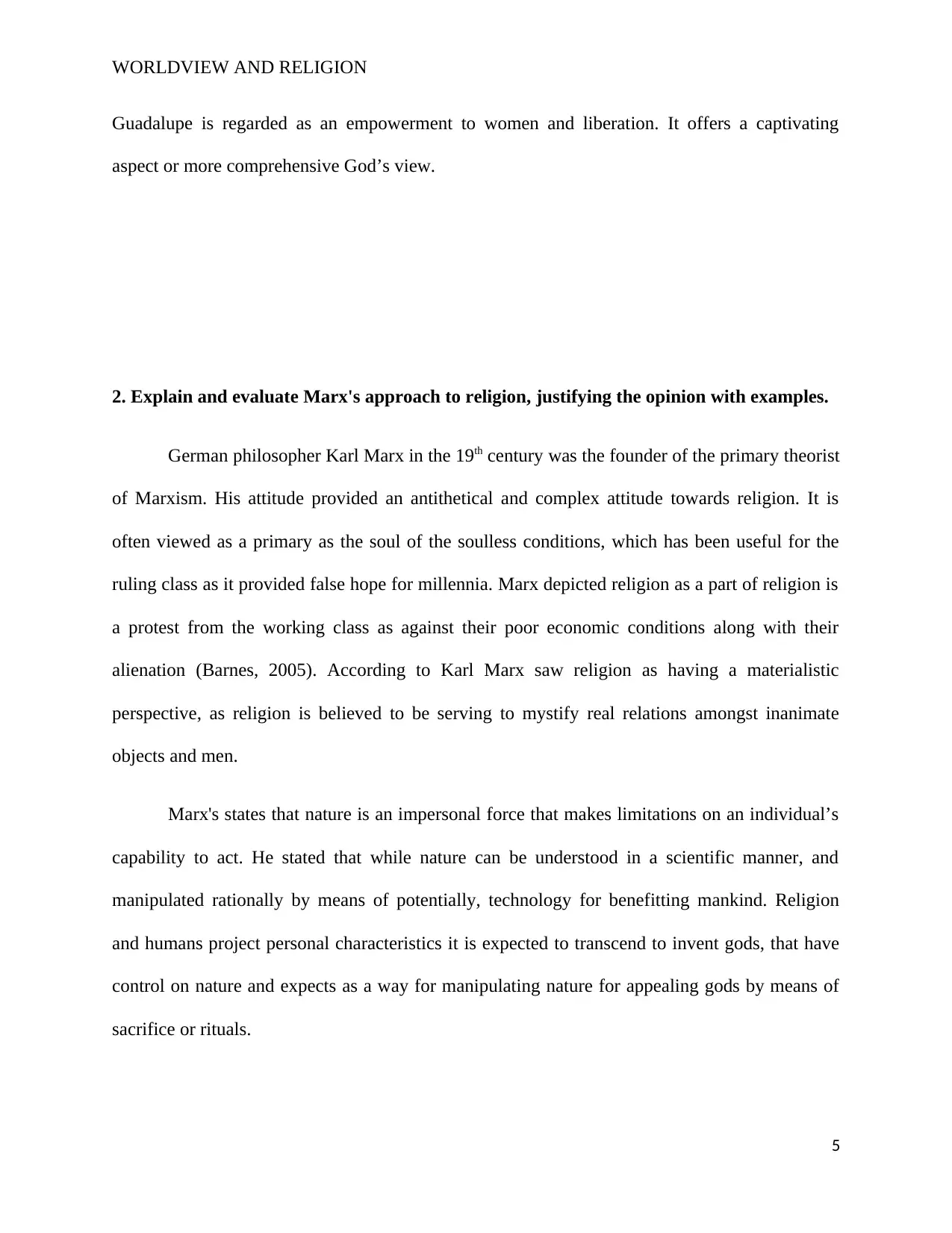
WORLDVIEW AND RELIGION
Guadalupe is regarded as an empowerment to women and liberation. It offers a captivating
aspect or more comprehensive God’s view.
2. Explain and evaluate Marx's approach to religion, justifying the opinion with examples.
German philosopher Karl Marx in the 19th century was the founder of the primary theorist
of Marxism. His attitude provided an antithetical and complex attitude towards religion. It is
often viewed as a primary as the soul of the soulless conditions, which has been useful for the
ruling class as it provided false hope for millennia. Marx depicted religion as a part of religion is
a protest from the working class as against their poor economic conditions along with their
alienation (Barnes, 2005). According to Karl Marx saw religion as having a materialistic
perspective, as religion is believed to be serving to mystify real relations amongst inanimate
objects and men.
Marx's states that nature is an impersonal force that makes limitations on an individual’s
capability to act. He stated that while nature can be understood in a scientific manner, and
manipulated rationally by means of potentially, technology for benefitting mankind. Religion
and humans project personal characteristics it is expected to transcend to invent gods, that have
control on nature and expects as a way for manipulating nature for appealing gods by means of
sacrifice or rituals.
5
Guadalupe is regarded as an empowerment to women and liberation. It offers a captivating
aspect or more comprehensive God’s view.
2. Explain and evaluate Marx's approach to religion, justifying the opinion with examples.
German philosopher Karl Marx in the 19th century was the founder of the primary theorist
of Marxism. His attitude provided an antithetical and complex attitude towards religion. It is
often viewed as a primary as the soul of the soulless conditions, which has been useful for the
ruling class as it provided false hope for millennia. Marx depicted religion as a part of religion is
a protest from the working class as against their poor economic conditions along with their
alienation (Barnes, 2005). According to Karl Marx saw religion as having a materialistic
perspective, as religion is believed to be serving to mystify real relations amongst inanimate
objects and men.
Marx's states that nature is an impersonal force that makes limitations on an individual’s
capability to act. He stated that while nature can be understood in a scientific manner, and
manipulated rationally by means of potentially, technology for benefitting mankind. Religion
and humans project personal characteristics it is expected to transcend to invent gods, that have
control on nature and expects as a way for manipulating nature for appealing gods by means of
sacrifice or rituals.
5
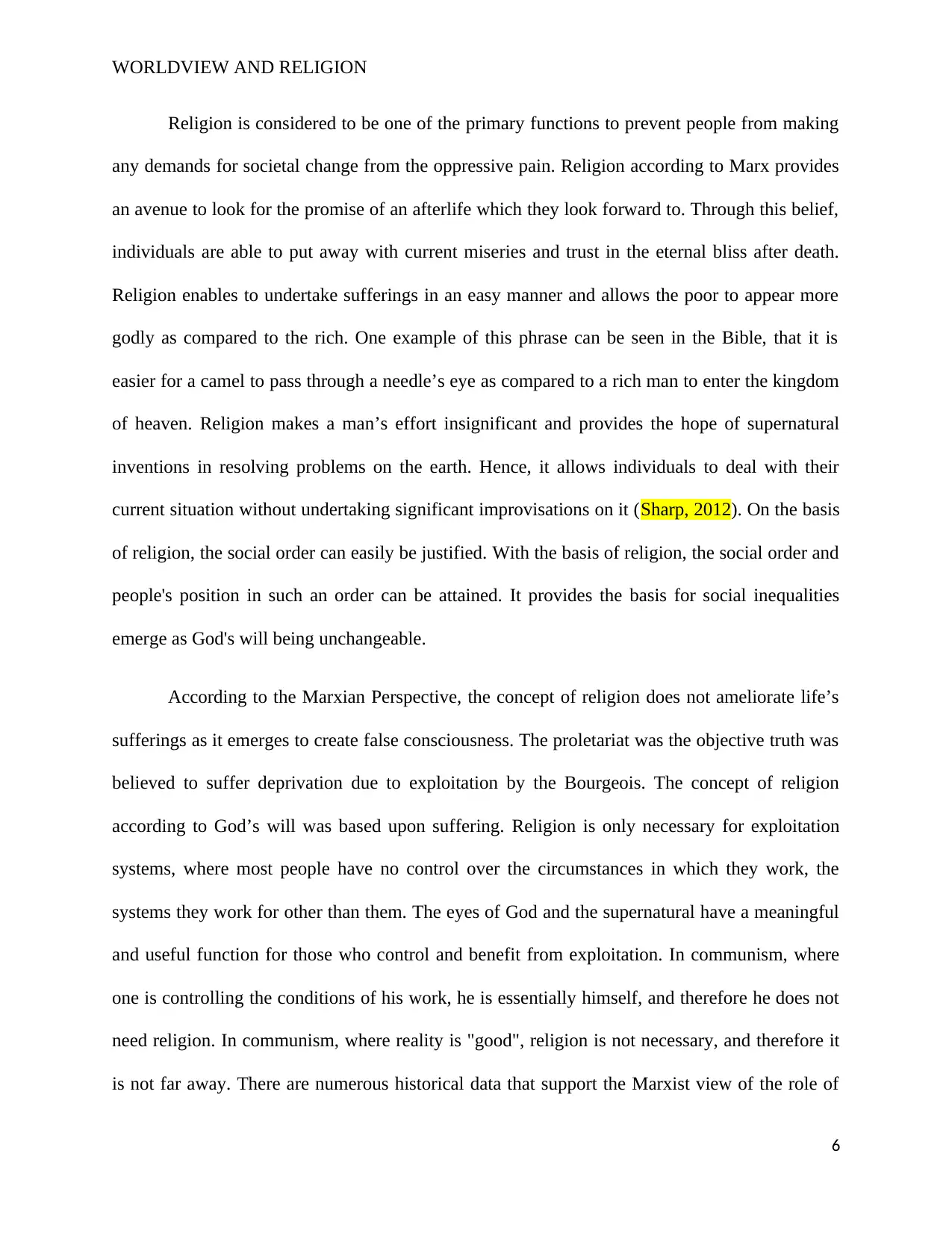
WORLDVIEW AND RELIGION
Religion is considered to be one of the primary functions to prevent people from making
any demands for societal change from the oppressive pain. Religion according to Marx provides
an avenue to look for the promise of an afterlife which they look forward to. Through this belief,
individuals are able to put away with current miseries and trust in the eternal bliss after death.
Religion enables to undertake sufferings in an easy manner and allows the poor to appear more
godly as compared to the rich. One example of this phrase can be seen in the Bible, that it is
easier for a camel to pass through a needle’s eye as compared to a rich man to enter the kingdom
of heaven. Religion makes a man’s effort insignificant and provides the hope of supernatural
inventions in resolving problems on the earth. Hence, it allows individuals to deal with their
current situation without undertaking significant improvisations on it (Sharp, 2012). On the basis
of religion, the social order can easily be justified. With the basis of religion, the social order and
people's position in such an order can be attained. It provides the basis for social inequalities
emerge as God's will being unchangeable.
According to the Marxian Perspective, the concept of religion does not ameliorate life’s
sufferings as it emerges to create false consciousness. The proletariat was the objective truth was
believed to suffer deprivation due to exploitation by the Bourgeois. The concept of religion
according to God’s will was based upon suffering. Religion is only necessary for exploitation
systems, where most people have no control over the circumstances in which they work, the
systems they work for other than them. The eyes of God and the supernatural have a meaningful
and useful function for those who control and benefit from exploitation. In communism, where
one is controlling the conditions of his work, he is essentially himself, and therefore he does not
need religion. In communism, where reality is "good", religion is not necessary, and therefore it
is not far away. There are numerous historical data that support the Marxist view of the role of
6
Religion is considered to be one of the primary functions to prevent people from making
any demands for societal change from the oppressive pain. Religion according to Marx provides
an avenue to look for the promise of an afterlife which they look forward to. Through this belief,
individuals are able to put away with current miseries and trust in the eternal bliss after death.
Religion enables to undertake sufferings in an easy manner and allows the poor to appear more
godly as compared to the rich. One example of this phrase can be seen in the Bible, that it is
easier for a camel to pass through a needle’s eye as compared to a rich man to enter the kingdom
of heaven. Religion makes a man’s effort insignificant and provides the hope of supernatural
inventions in resolving problems on the earth. Hence, it allows individuals to deal with their
current situation without undertaking significant improvisations on it (Sharp, 2012). On the basis
of religion, the social order can easily be justified. With the basis of religion, the social order and
people's position in such an order can be attained. It provides the basis for social inequalities
emerge as God's will being unchangeable.
According to the Marxian Perspective, the concept of religion does not ameliorate life’s
sufferings as it emerges to create false consciousness. The proletariat was the objective truth was
believed to suffer deprivation due to exploitation by the Bourgeois. The concept of religion
according to God’s will was based upon suffering. Religion is only necessary for exploitation
systems, where most people have no control over the circumstances in which they work, the
systems they work for other than them. The eyes of God and the supernatural have a meaningful
and useful function for those who control and benefit from exploitation. In communism, where
one is controlling the conditions of his work, he is essentially himself, and therefore he does not
need religion. In communism, where reality is "good", religion is not necessary, and therefore it
is not far away. There are numerous historical data that support the Marxist view of the role of
6
⊘ This is a preview!⊘
Do you want full access?
Subscribe today to unlock all pages.

Trusted by 1+ million students worldwide
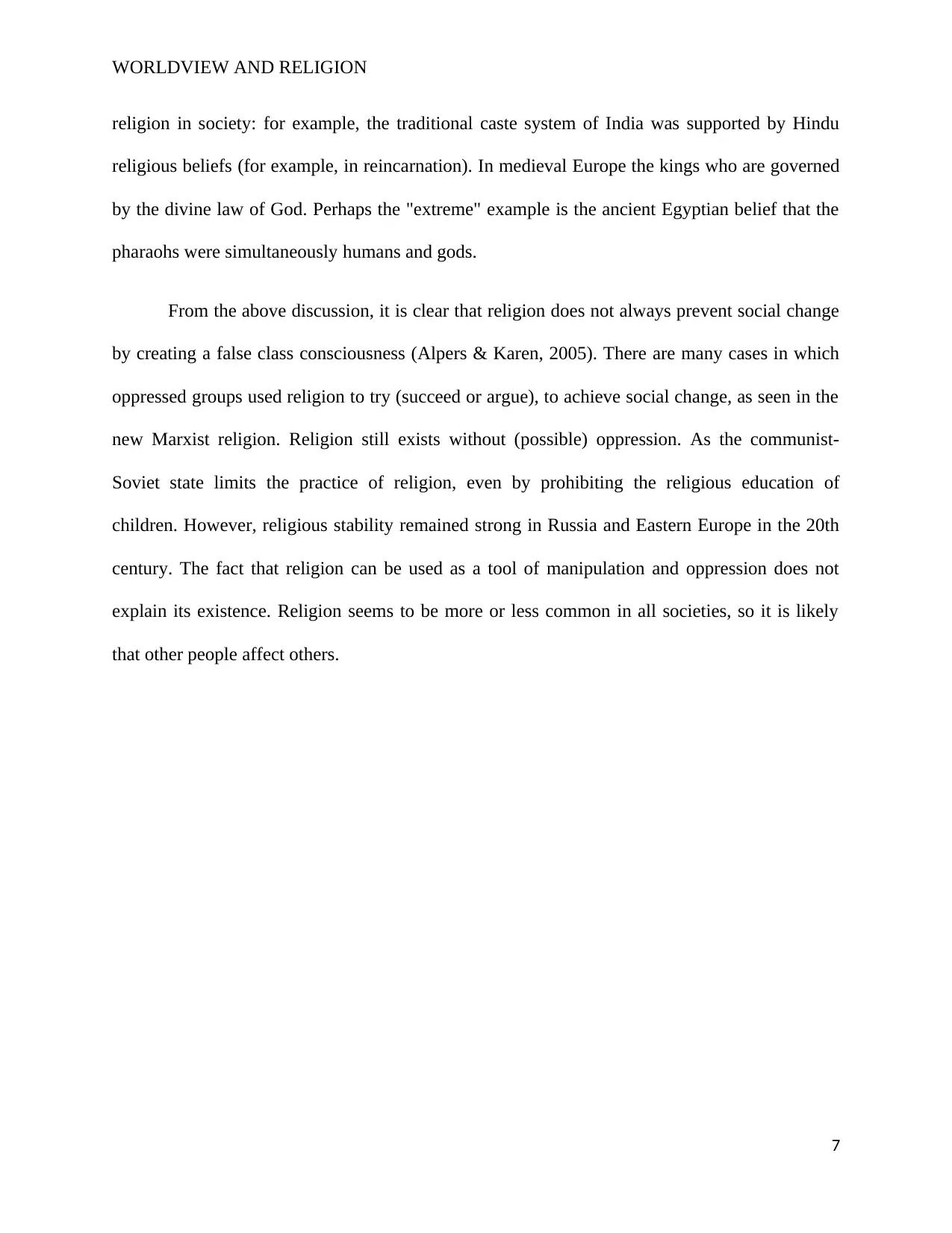
WORLDVIEW AND RELIGION
religion in society: for example, the traditional caste system of India was supported by Hindu
religious beliefs (for example, in reincarnation). In medieval Europe the kings who are governed
by the divine law of God. Perhaps the "extreme" example is the ancient Egyptian belief that the
pharaohs were simultaneously humans and gods.
From the above discussion, it is clear that religion does not always prevent social change
by creating a false class consciousness (Alpers & Karen, 2005). There are many cases in which
oppressed groups used religion to try (succeed or argue), to achieve social change, as seen in the
new Marxist religion. Religion still exists without (possible) oppression. As the communist-
Soviet state limits the practice of religion, even by prohibiting the religious education of
children. However, religious stability remained strong in Russia and Eastern Europe in the 20th
century. The fact that religion can be used as a tool of manipulation and oppression does not
explain its existence. Religion seems to be more or less common in all societies, so it is likely
that other people affect others.
7
religion in society: for example, the traditional caste system of India was supported by Hindu
religious beliefs (for example, in reincarnation). In medieval Europe the kings who are governed
by the divine law of God. Perhaps the "extreme" example is the ancient Egyptian belief that the
pharaohs were simultaneously humans and gods.
From the above discussion, it is clear that religion does not always prevent social change
by creating a false class consciousness (Alpers & Karen, 2005). There are many cases in which
oppressed groups used religion to try (succeed or argue), to achieve social change, as seen in the
new Marxist religion. Religion still exists without (possible) oppression. As the communist-
Soviet state limits the practice of religion, even by prohibiting the religious education of
children. However, religious stability remained strong in Russia and Eastern Europe in the 20th
century. The fact that religion can be used as a tool of manipulation and oppression does not
explain its existence. Religion seems to be more or less common in all societies, so it is likely
that other people affect others.
7
Paraphrase This Document
Need a fresh take? Get an instant paraphrase of this document with our AI Paraphraser
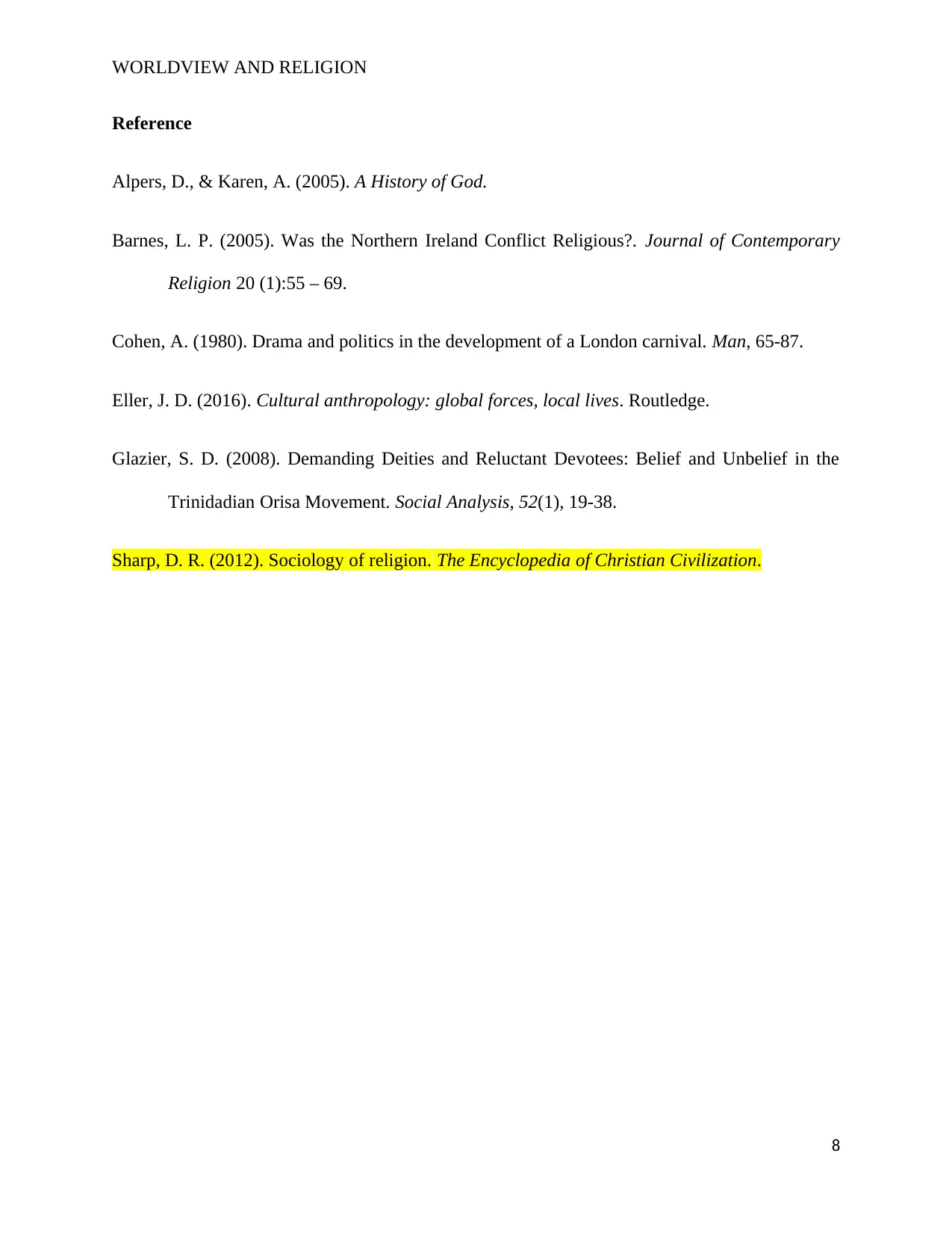
WORLDVIEW AND RELIGION
Reference
Alpers, D., & Karen, A. (2005). A History of God.
Barnes, L. P. (2005). Was the Northern Ireland Conflict Religious?. Journal of Contemporary
Religion 20 (1):55 – 69.
Cohen, A. (1980). Drama and politics in the development of a London carnival. Man, 65-87.
Eller, J. D. (2016). Cultural anthropology: global forces, local lives. Routledge.
Glazier, S. D. (2008). Demanding Deities and Reluctant Devotees: Belief and Unbelief in the
Trinidadian Orisa Movement. Social Analysis, 52(1), 19-38.
Sharp, D. R. (2012). Sociology of religion. The Encyclopedia of Christian Civilization.
8
Reference
Alpers, D., & Karen, A. (2005). A History of God.
Barnes, L. P. (2005). Was the Northern Ireland Conflict Religious?. Journal of Contemporary
Religion 20 (1):55 – 69.
Cohen, A. (1980). Drama and politics in the development of a London carnival. Man, 65-87.
Eller, J. D. (2016). Cultural anthropology: global forces, local lives. Routledge.
Glazier, S. D. (2008). Demanding Deities and Reluctant Devotees: Belief and Unbelief in the
Trinidadian Orisa Movement. Social Analysis, 52(1), 19-38.
Sharp, D. R. (2012). Sociology of religion. The Encyclopedia of Christian Civilization.
8
1 out of 8
Your All-in-One AI-Powered Toolkit for Academic Success.
+13062052269
info@desklib.com
Available 24*7 on WhatsApp / Email
![[object Object]](/_next/static/media/star-bottom.7253800d.svg)
Unlock your academic potential
Copyright © 2020–2025 A2Z Services. All Rights Reserved. Developed and managed by ZUCOL.
